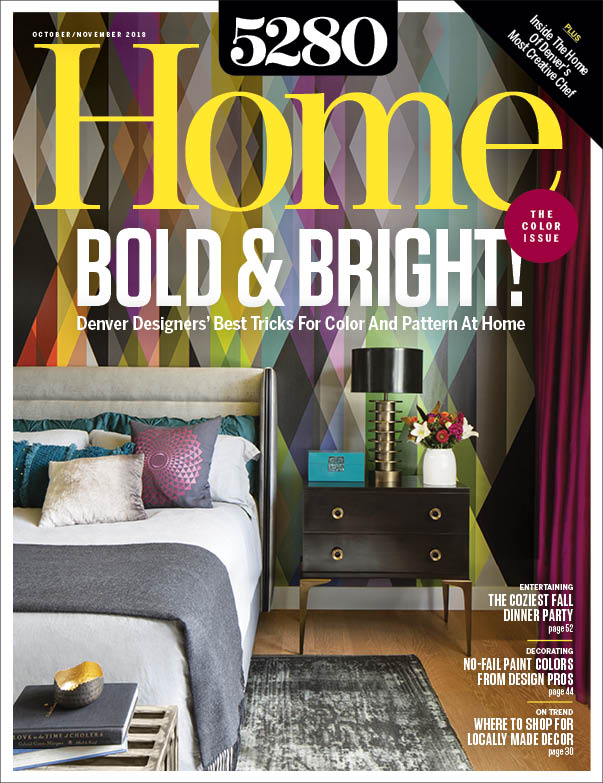The Local newsletter is your free, daily guide to life in Colorado. For locals, by locals.
Set on a pristine lot in Denver’s tree-lined Country Club neighborhood, this traditional 1922 home should have been a beacon of taste and style that reflected its surroundings. Instead, when the owners first saw the for-sale house, they were met with a dated, poorly lit interior with odd design elements and blah, brown walls. But they also saw what the home could be: an inviting space that’s classically elegant and—with some help—fresh and bright.
So they took the proverbial plunge and engaged Duet Design Group to bring those possibilities to life. “[Duet] did a great job capturing my vision, which was traditional mixed with contemporary and a little bit of Art Deco,” says the owner. “I like layering and different textures.” With a few critical structural changes to open up the layout, new paint to lighten the rooms, and thoughtful extras like the addition of architectural details on the ceiling, the foundation was laid. Here, Duet co-founder and interior designer Devon Tobin talks mixing styles, pushing limits, and the art of going glam.
5280 Home: Give us the big picture here.
Devon Tobin: We wanted to maintain classical overtones but add unexpected pops of color. The clients have really good taste. When clients show me something that, as a designer, makes me super-inspired, the outcome is magical. The homeowners were eager to take risks with us and were comfortable exploring a level of discomfort.
What do you mean?
Clients will often say to us, “I don’t know if that works.” I’ll come back and say: “I’ll never show you something that doesn’t work; if you don’t like it, that’s different.” These homeowners never questioned that. It’s exciting when the client says, “I never would have done that—but it looks so good!”

interest, while furnishings like the area rug (hand-knotted bamboo silk from S&H Rugs) and agate-topped Mustique cocktail table (by Mr. & Mrs. Howard for Sherrill Furniture) keep the overall vibe contemporary and colorful. Photograph by Emily Minton Redfield
How did the home’s bones influence the interiors?
The house was actually lacking a lot of architectural character. We had to add interior architectural details—kind of bring it back to its original authenticity. For example, [we installed] the living room ceiling details and updated the fireplace and added the built-ins in the family room. We also opened the sunroom and added French doors.
You’ve blended traditional with fresh-and-updated—seamlessly. What’s your secret?
The furnishings are really classical. When I’m designing and pushing limits, [I make sure] those lines of design don’t fight each other, but instead complement each other. In the blue living room, that sofa is actually from the owner’s great-grandmother, and the lines are simple. Everything I surrounded it with had a simple elegance, too. Even the drapery style is a little ode to high-estate, but with a 21st-century Schumacher print.
Where is the best example of pushing boundaries here?
I really push limits with color. This is a young family. I didn’t want the home to get too sophisticated, too earnest. Take the peacock wallcovering over the fireplace: Most people wouldn’t have taken that risk. The fact that they did is killer.

the fixtures’ wow factor. Photograph by Emily Minton Redfield
And then, of course, you have the glam elements, like the chandeliers. How do you not overdo the glitz?
It’s done subtly. We said, “Let’s let the lighting be the jewelry of this house. Everything else surrounding it needs to be more subtle; we can’t have you totally decked out in diamonds.”
So this super-fun layering of color and pattern—it’s about trust, in a way.
I once heard someone say: “We tend to underestimate the power of a conductor.” When every single person in the orchestra is ready, you swiftly pull an arm down and if you get it right, you’ll go, “Holy cow—every single person hit the note perfectly.” That’s what happens when design is flawless: Every note—scale and function and color and pattern—is perfect. If you allow me to conduct this orchestra, the pitch will be perfect.

interest, while furnishings like the area rug (hand-knotted bamboo silk from S&H Rugs) and agate-topped Mustique cocktail table (by Mr. & Mrs. Howard for Sherrill Furniture) keep the overall vibe contemporary and colorful. Photograph by Emily Minton Redfield
Design Pro
Interior design: Devon Tobin, Duet Design Group
Architecture: Missy Brown, Missy Brown Architecture & Design
Construction: Canady Construction Inc.









